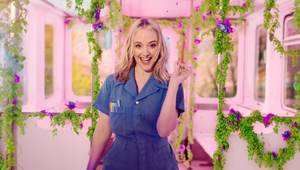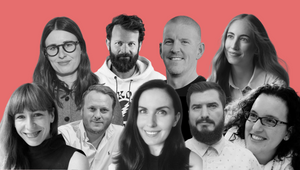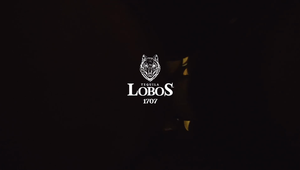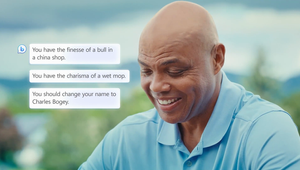
Thinking In Sound: Why It's All About Trust for Kieran Kaye

Kieran Kaye, a British-born sound designer and engineer, embarked on his professional journey after completing his education in the UK. He ventured to New York City to work at a prestigious voice-over studio in Manhattan, where he honed his skills amidst the city's vibrant audio scene. Seeking new challenges, Kieran later relocated to London to immerse himself in the commercial advertising industry, collaborating with top agencies and production companies to refine his craft.
After years of freelancing and mastering his art, Kieran returned to New York City and founded Full English Post in 2016. Situated in Brooklyn, Full English Post is committed to setting the highest standards in recording, sound design, and mixing - offering streamlined workflows and an unwavering commitment to excellence.
At Full English Post, Kieran and his dedicated team work closely with clients to elevate their visions through the power of sound. With a culture rooted in passion, pride, and meticulous attention to detail, they ensure that each project receives the utmost care and consideration. Through their emphasis on efficiency, transparent communication, and a focus on delivering exceptional value, Full English Post continues to redefine the boundaries of audio production, creating immersive experiences that resonate with audiences worldwide.
LBB> When you’re working on a new brief or project, what’s your typical starting point? How do you break it down and how do you like to generate your ideas or response?
Kieran> Each project is different with varying degrees of clients wanting to be hands on or hands off when it comes to sound, but the first place that we usually start is a kick-off call or meeting with the client. People trust us to do our thing so often this is sometimes as brief as an email to outline the sonic gist of the content.
We’ll sometimes get the original treatment/deck sent through to give us the vibe but for the most part, after a meeting with the creative director (or whoever is running the show creatively) they just leave us to our own devices. Communication is key though and something we pride ourselves on. While we like to just crack on, it’s so important to ask questions and communicate with the client about anything and everything.
It’s about trust and Full English has been in the game a while now so overall, they come to us knowing they’re going to get a great service and outcome.
Then when it comes to start the project, it’s usually the same breakdown for me: dialogue / VO first.
This is the most important part of storytelling. The literal and figurative voice. It’s important to prioritise this element otherwise there is no story. There’s exceptions of course where the sound design is the main voice but for the most part I’m getting the dialogue clean and balanced. I do this without any SFX or music in place, I want every element to sound perfect even without its counterpart. But during this stage I’m marking where sound design needs to be placed and thinking of creative ideas as I go.
Secondly, it’s the sound design. This could be as simple as adding ambient tracks for each scene or as complex as designing new worlds or otherworldly vehicles / weapons etc. While sound designing I’m also balancing the SFX roughly with the dialogue mix to make sure things are clashing or taking away / adding too much in context.
Then the final element is bringing the music into the mix. Usually I don’t have the privilege of stems for the musical elements so I have to ensure that all my added sound design fits perfectly with any sonic goodness the music brings. Sometimes I’ll bring the music in with something I sound designed and it just doesn’t gel. Back to the drawing board!
Once all three elements are working together well I’ll begin a final mix and finishing touches such as reverbs, effects, panning. This is where I try to be less micro focussed and see / hear the project in its entirety, making sure everything sounds balanced holistically.
LBB> Music and sound are in some ways the most collaborative and interactive forms of creativity - what are your thoughts on this? Do you prefer to work solo or with a gang - and what are some of your most memorable professional collaborations?
Kieran> We have a small team at Full English and for the most part we have to spread ourselves out and work solo. This is the way I’ve worked in most studios throughout my career. Budgets are often smaller and spread more thinly so gone are the days of having assistants or multiple engineers on one job.
That said, we regularly have small huddles and discussions about projects to get second, third opinions etc. Just a sounding board is very helpful creatively…”hey mate, can you listen to this, what's your thoughts, where should I place this, does the door slam sound right etc”.
Again, communication is so powerful and I find that attended mix sessions with the client tend to be the most collaborative / creative. But these days clients aren’t always nearby and there’s often not time to have a sull mix session so more often than not it’s a solo effort and sending to client for notes / feedback.
LBB>What’s the most satisfying part of your job and why?
Kieran> The variety. At Full English Post, we cast a wide net in the diversity of projects we work on. This has partly happened organically as we grow our client network but it is also partly orchestrated to adapt to an ever-changing industry. Be it a pandemic, strikes, recessions, as a business we have to be resilient and flexible to whatever the world / industry throws at us. Because of this it means we usually say yes to most projects, even if it’s something that wouldn’t normally be in our wheelhouse.
We’ve recently been venturing into the TV and film world, for example. While we’ve done this in the past, it made sense for us to take on a few more projects recently that we wouldn’t normally have taken on. But I love taking on new challenges and ultimately it means that everyday is different. I’ll be recording a voice over with a celeb one minute, then hopping over to sound design a commercial, then jump into a podcast mix. It really is satisfying knowing we can adapt to all these different genres and styles of storytelling.
LBB> As the advertising industry changes, how do you think the role of music and sound is changing with it?
Kieran> Obviously everyone is talking about AI generated content and while it seems to be more visually focused right now, I’m noticing more audio AI gadgets hitting the market. Perhaps I’m naïve or old school but I don’t see AI replacing post production audio anytime soon. I think it can actually work in sound designers' favour for dialogue clean-up and manipulation etc.
Then of course you have the AI generated voice overs which actors aren’t too happy about but I think there’ll always be a need for amazing talent that just can’t be replaced by AI.
I also think the role of sound has changed since the pandemic and even before that with more and more social content. We see less attended mix sessions now and people are happy to review from home.
I think in-person sessions can be extremely productive but also, scheduling is tough so if we can send out a mix and the client reviews on their own time, it opens up studio time for other projects. With social media content, it’s very quick turnarounds and it changes the way we mix. We have to assume someone is watching this on their phone.
Mixers have always had to work in a way that translates on many platforms so nothing has really changed there but knowing it's going to be played from a phone speaker is definitely a priority in our social mix decisions, more so than ever.
LBB> Who are your musical or audio heroes and why?
Kieran> Hans Zimmer is a classic example of creative (and business) adaptability. He’s obviously got such an eclectic career but I believe that’s down to him simply saying yes to as many projects as possible over the years.
He’s worked on some really surprisingly low budget or uncool films and then of course the big boys like many Chris Nolan films and that’s what Hans is known for. He doesn’t give a shit, just does what he’s good at in any environment. I truly admire his ability to wear so many different hats and as a business owner and creative, it’s inspiring to see. Some projects are for the reel, some are for the meal… as they say.
As for sound design, Lon Bender’s work is terrific. Specifically The Revenant. While it’s obvious to credit sound designers for innovative audio for things like Star Wars, creating a soundscape that literally feels cold and baron and places the audience in that space is very difficult to achieve. There’s a lot of time in The Revenant where there’s no dialogue and the soundscape truly tells the story by itself. From the micro focussed snow drips and footsteps, to the famous bear scene… it feels like you’re there.
LBB> And when it comes to your particular field, whether sound design or composing, are there any particular ideas or pioneers that you go back to frequently or who really influence your thinking about the work you do?
Kieran> I love the power of understated sound design. The sound of silence. I often use silence (not literal silence, of course!) to create a more powerful punch when the moment finally hits.
I’m also a fan of quick, hard cut sound design. Edgar Wright often does this for impact and I love it. The ‘car chase’ in Hot Fuzz lasts about five seconds but with the quick cut shots and SFX it’s really exciting for that time then the comedic value hits as soon as it’s over and is quiet again. Requiem for a Dream is another film with this quick cut sound design and it’s just so powerful so where I can, I try to introduce that into my sound design.
LBB> When you’re working on something that isn’t directly sound design or music, are you the sort of person who needs music and noise in the background or is that completely distracting to you? What are your thoughts on ‘background’ sound and music as you work?
Kieran> This is an interesting topic of discussion, one that I have frequently. When I’m at the studio, I’m constantly stimulated by sound so I don’t like to even listen to music while I’m doing admin.
I tend to hone in on specific sounds and I’ll end up analysing and critiquing what I’m listening to rather than responding to emails or getting invoices sent out! Podcasts are even worse to the point that I simply can’t listen to them anymore. I would get bothered by bad edits or mouth noises and be completely distracted from the task I’m supposed to be doing! I’ll admit that I’m not the best at multitasking so added distraction is not usually advised if I want to continue running a business successfully!
LBB> I guess the quality of the listening experience and the context that audiences listen to music/sound in has changed over the years. There’s the switch from analogue to digital and now we seem to be divided between bad-ass surround-sound immersive experiences and on-the-go, low quality sound (often the audio is competing with a million other distractions) - how does that factor into how you approach your work?
Kieran> We currently live in a world with a very short attention span. Most deliverables for commercials we work on now have a six second cutdown for social. How do you tell a story in such a short time?
Do people even care about the sound when they’re scrolling? It’s likely not (a lot of people never even have their sound on). Despite this, the overall quality of devices and playback is always improving. The amount of people that spend a lot of money on headphones has significantly increased in recent years. If you look around in public, almost everyone has headphones on and they’re usually at a minimum AirPods ($250 for the Pro, $550 for the AirPods Max!), or Beats, which aren’t cheap headphones.
This means that people are willing to pay for higher quality audio which gives me some hope. All of this factors into some of our creative decisions… how do we make this translate to various playback devices (including phone speakers and laptops)? How do we capture someone's attention with audio? Well, usually it has to be very engaging if we’re to sell a product in six seconds. This depends on the visuals that we’re working to but we try to pack a punch where possible.
LBB> On a typical day, what does your ‘listening diet’ look like?
Kieran> On my way to work it’s just chill music or sometimes nothing! Then of course during the day my ears are battered with a huge variety of content so by the time the day is done I just want chill music again!
LBB> Do you have a collection of music/sounds and what shape does it take (are you a vinyl nerd, do you have hard drives full of random bird sounds, are you a hyper-organised Spotify-er…)?
Kieran> Over the years I’ve built up a huge collection of sounds. Whether it’s my own Foley or purchased libraries, or even CDs I transferred to a hard drive years ago I have a pretty eclectic database. All of this is now on a central server at the studio and we use Soundly to search and spot SFX for our sessions. They also have a fairly good cloud library that’s included with the subscription or you can purchase SFX ad hoc as you might need them.
It’s a great way to keep everything in one place and the search engine/UI on Soundly does a great job with very little effort.
LBB> Outside of the music and sound world, what sort of art or topics really excite you and do you ever relate that back to music?
Kieran> I’m personally a pretty big fan of movies, but I’m not educated in that world. If someone starts talking to me about niche directors or classic films that most film students learn about, I likely won’t know what they’re talking about! Despite being in the industry I tend to be able to switch off and see movies at face value rather than over analysing them and point out bad edits or comment on the technical side of things visually.
In my opinion that’s a good thing since I can see content from the POV of the average audience better.
LBB> Let’s talk travel! It’s often cited as one of the most creatively inspiring things you can do - I’d love to know what are the most exciting or inspiring experiences you’ve had when it comes to sound and music on your travels?
Kieran> Being a business owner and a parent of young kids makes traveling difficult unfortunately but I’m constantly living my life in sound. Anywhere I go I try and think how I would recreate the ‘scene’ that I’m in. Sound design is all about layers so I analyse what is happening in any given environment. It’s super nerdy but I love to take note of what’s happening sonically.
Birds, crowds, footsteps, languages, it’s all inspiration and being in New York there’s a lot of things happening. Everyone with their own sonic agenda but all coming together to make the cacophony that is New York City. This helps me in my creative decision making when building scenes or adding room reverb for example so that I can make a recreated environment sound and feel as real as possible.
LBB> As we age, our ears change physically and our tastes evolve too, and life changes mean we don’t get to engage in our passions in the same intensity as in our youth - how has your relationship with sound and music changed over the years?
Kieran> My relationship with sound has only gotten stronger over the years. On a physical level I have my ears tested every few years and aside from the usual gradual deterioration of age, I’m in good shape which is a relief! On a passion level, I find myself listening to things on a more mature level and overall, sound is getting better and better for most content which keeps things interesting.
Think about the sounds from a 90s commercial compared to today, there’s so much richness happening even in the simplest commercial today, I bloody love it!















